Report on Employee Motivation and HR Practices at Telenor Myanmar
VerifiedAdded on 2020/05/16
|23
|7858
|291
Report
AI Summary
This report provides a comprehensive overview of employee motivation strategies implemented by Telenor Myanmar. It delves into the various financial rewards such as commissions, bonuses, and profit-sharing, as well as non-financial incentives like choice of work, training opportunities, and the chance to represent the company. The report further examines job satisfaction, job design techniques including job rotation, enlargement, and enrichment. It also explores motivation theories like Maslow's Hierarchy of Needs and Herzberg's Two-Factor Theory, the significance of cooperation, employment contracts, and employee involvement methods. Performance measurement, employee training, and the benefits of performance management within Telenor are also discussed, providing a holistic view of how the company fosters a motivated and productive workforce. The report concludes by summarizing the key findings and highlighting the importance of these strategies in Telenor's success.
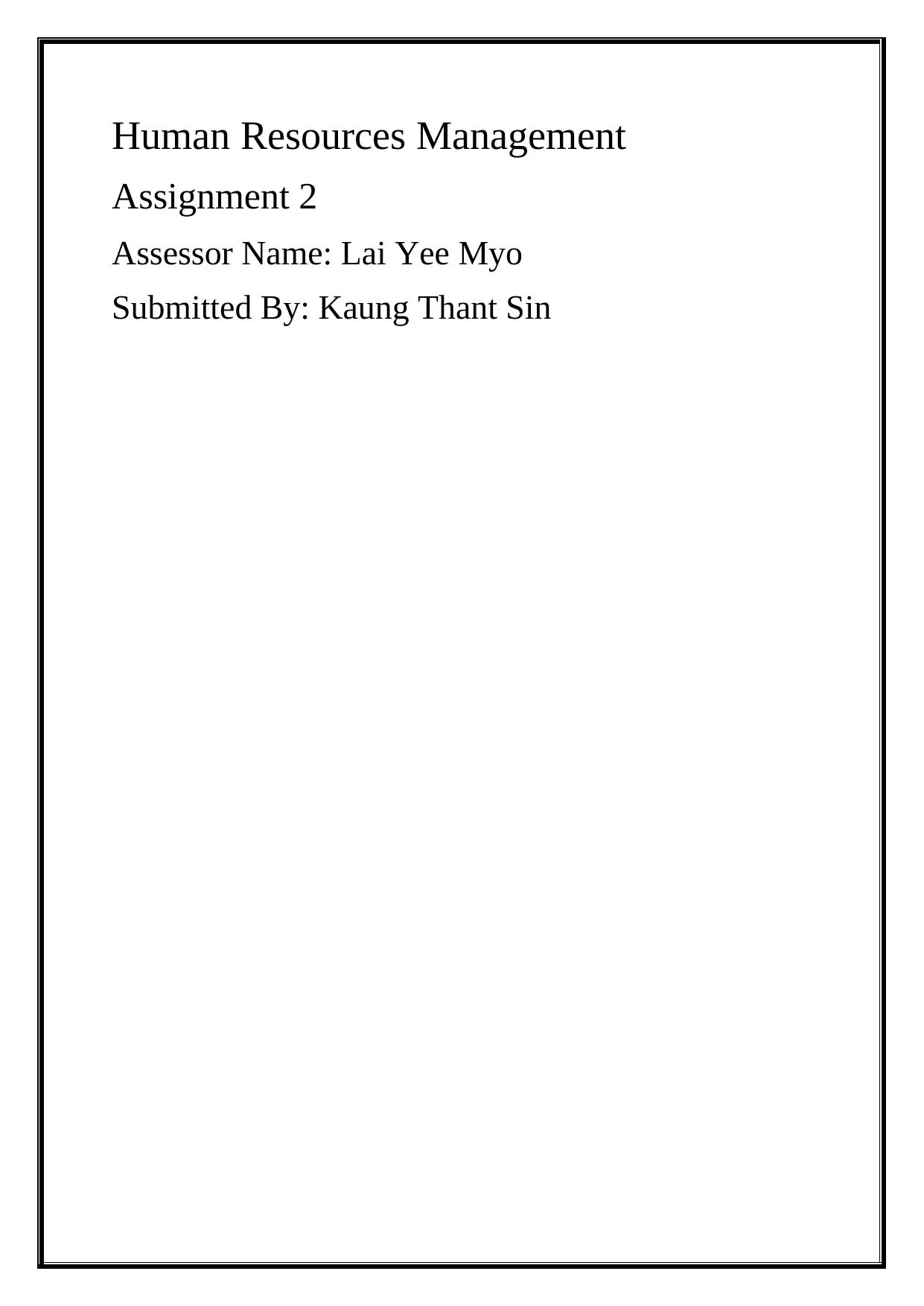
Human Resources Management
Assignment 2
Assessor Name: Lai Yee Myo
Submitted By: Kaung Thant Sin
Assignment 2
Assessor Name: Lai Yee Myo
Submitted By: Kaung Thant Sin
Paraphrase This Document
Need a fresh take? Get an instant paraphrase of this document with our AI Paraphraser
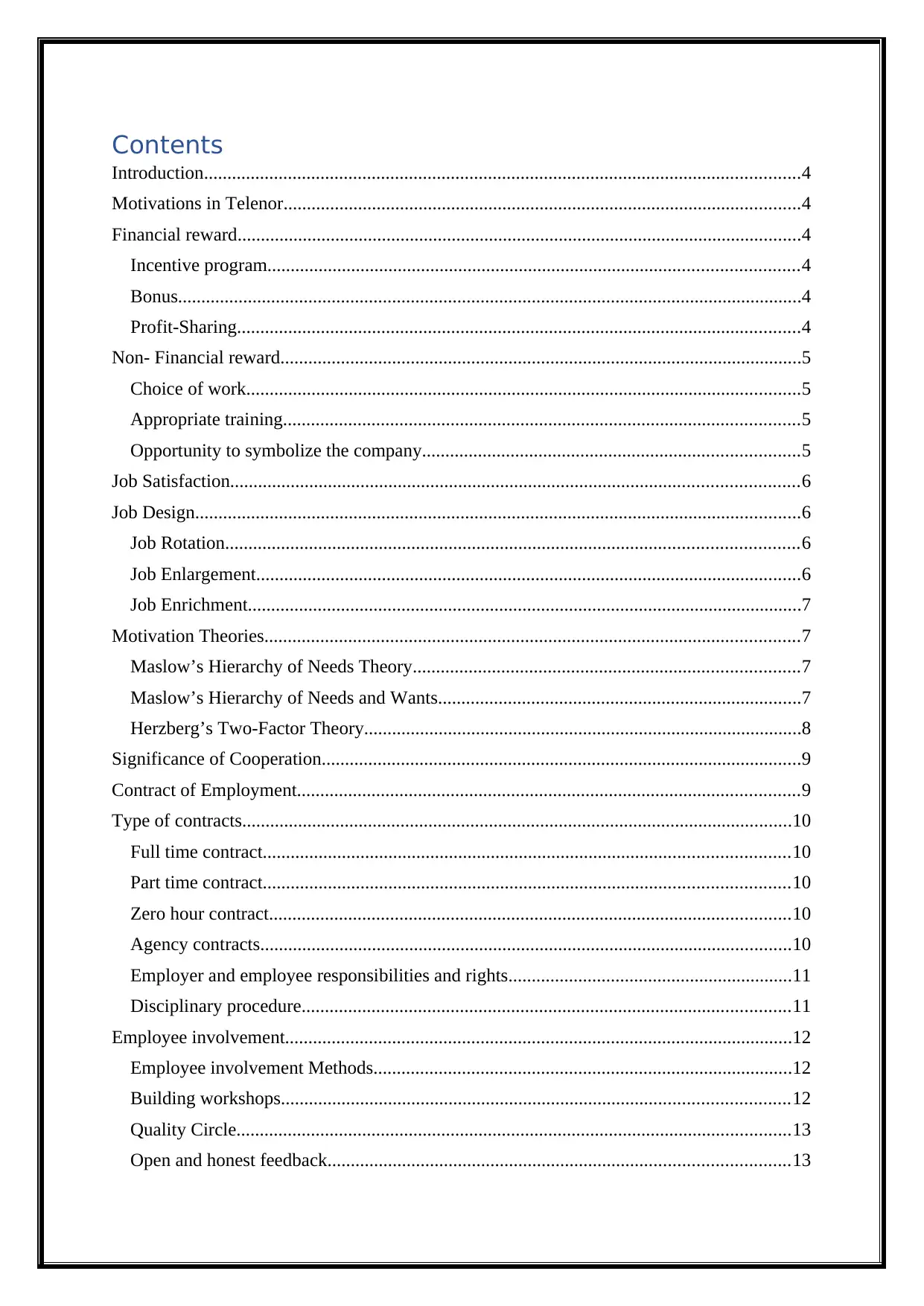
Contents
Introduction................................................................................................................................4
Motivations in Telenor...............................................................................................................4
Financial reward.........................................................................................................................4
Incentive program..................................................................................................................4
Bonus......................................................................................................................................4
Profit-Sharing.........................................................................................................................4
Non- Financial reward................................................................................................................5
Choice of work.......................................................................................................................5
Appropriate training...............................................................................................................5
Opportunity to symbolize the company.................................................................................5
Job Satisfaction..........................................................................................................................6
Job Design..................................................................................................................................6
Job Rotation...........................................................................................................................6
Job Enlargement.....................................................................................................................6
Job Enrichment.......................................................................................................................7
Motivation Theories...................................................................................................................7
Maslow’s Hierarchy of Needs Theory...................................................................................7
Maslow’s Hierarchy of Needs and Wants..............................................................................7
Herzberg’s Two-Factor Theory..............................................................................................8
Significance of Cooperation.......................................................................................................9
Contract of Employment............................................................................................................9
Type of contracts......................................................................................................................10
Full time contract.................................................................................................................10
Part time contract.................................................................................................................10
Zero hour contract................................................................................................................10
Agency contracts..................................................................................................................10
Employer and employee responsibilities and rights.............................................................11
Disciplinary procedure.........................................................................................................11
Employee involvement.............................................................................................................12
Employee involvement Methods..........................................................................................12
Building workshops.............................................................................................................12
Quality Circle.......................................................................................................................13
Open and honest feedback...................................................................................................13
Introduction................................................................................................................................4
Motivations in Telenor...............................................................................................................4
Financial reward.........................................................................................................................4
Incentive program..................................................................................................................4
Bonus......................................................................................................................................4
Profit-Sharing.........................................................................................................................4
Non- Financial reward................................................................................................................5
Choice of work.......................................................................................................................5
Appropriate training...............................................................................................................5
Opportunity to symbolize the company.................................................................................5
Job Satisfaction..........................................................................................................................6
Job Design..................................................................................................................................6
Job Rotation...........................................................................................................................6
Job Enlargement.....................................................................................................................6
Job Enrichment.......................................................................................................................7
Motivation Theories...................................................................................................................7
Maslow’s Hierarchy of Needs Theory...................................................................................7
Maslow’s Hierarchy of Needs and Wants..............................................................................7
Herzberg’s Two-Factor Theory..............................................................................................8
Significance of Cooperation.......................................................................................................9
Contract of Employment............................................................................................................9
Type of contracts......................................................................................................................10
Full time contract.................................................................................................................10
Part time contract.................................................................................................................10
Zero hour contract................................................................................................................10
Agency contracts..................................................................................................................10
Employer and employee responsibilities and rights.............................................................11
Disciplinary procedure.........................................................................................................11
Employee involvement.............................................................................................................12
Employee involvement Methods..........................................................................................12
Building workshops.............................................................................................................12
Quality Circle.......................................................................................................................13
Open and honest feedback...................................................................................................13
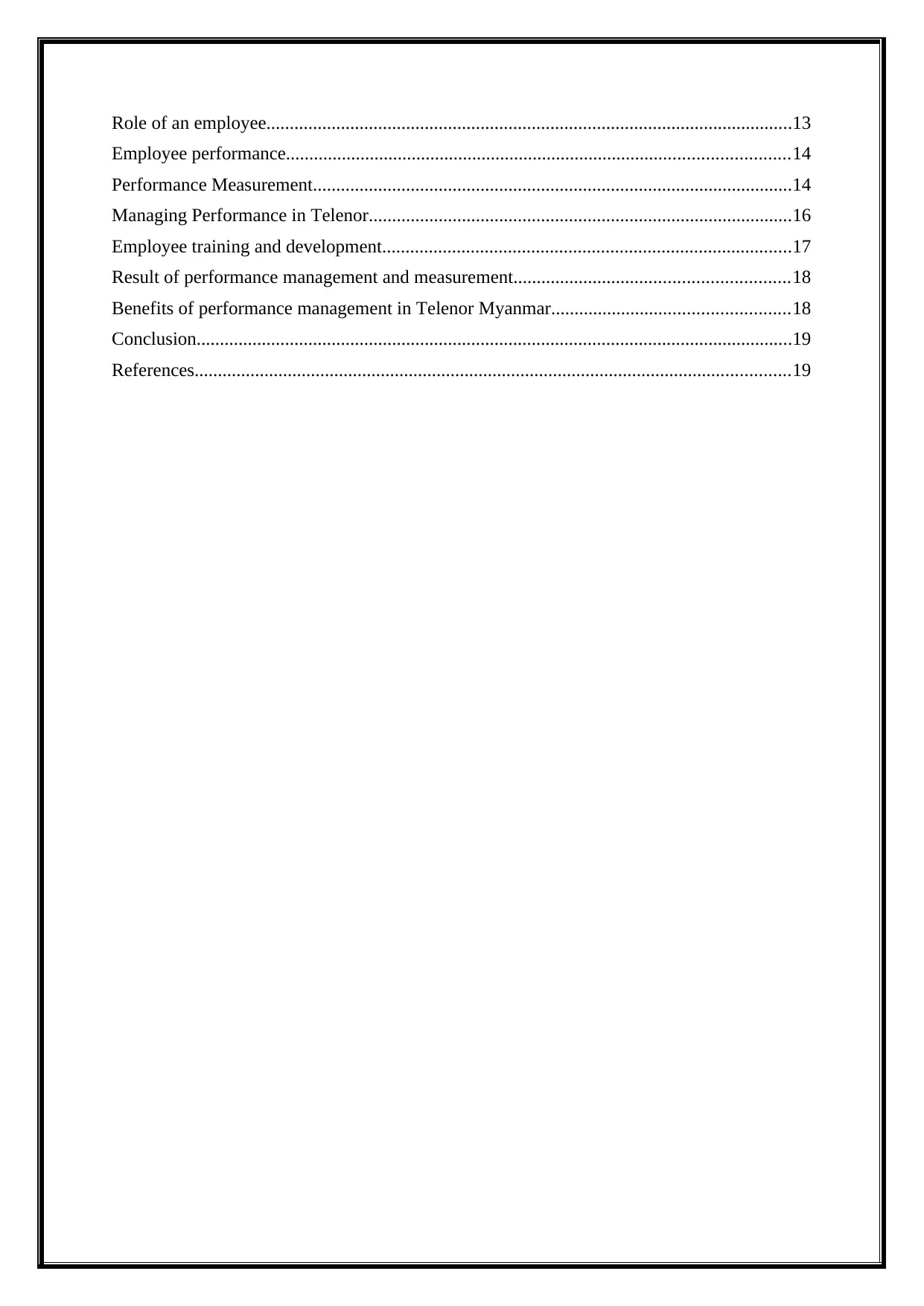
Role of an employee.................................................................................................................13
Employee performance............................................................................................................14
Performance Measurement.......................................................................................................14
Managing Performance in Telenor...........................................................................................16
Employee training and development........................................................................................17
Result of performance management and measurement...........................................................18
Benefits of performance management in Telenor Myanmar...................................................18
Conclusion................................................................................................................................19
References................................................................................................................................19
Employee performance............................................................................................................14
Performance Measurement.......................................................................................................14
Managing Performance in Telenor...........................................................................................16
Employee training and development........................................................................................17
Result of performance management and measurement...........................................................18
Benefits of performance management in Telenor Myanmar...................................................18
Conclusion................................................................................................................................19
References................................................................................................................................19
⊘ This is a preview!⊘
Do you want full access?
Subscribe today to unlock all pages.

Trusted by 1+ million students worldwide
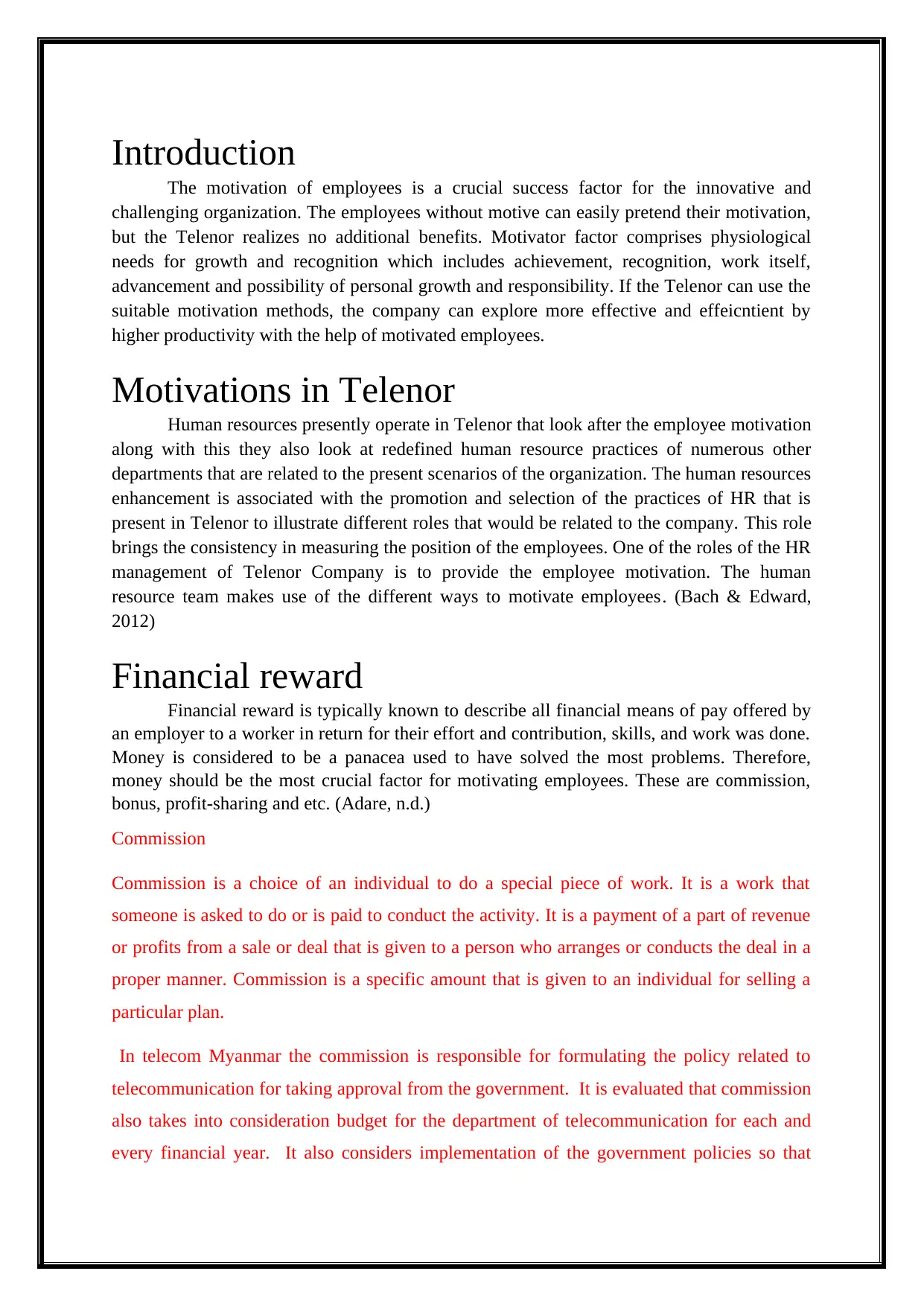
Introduction
The motivation of employees is a crucial success factor for the innovative and
challenging organization. The employees without motive can easily pretend their motivation,
but the Telenor realizes no additional benefits. Motivator factor comprises physiological
needs for growth and recognition which includes achievement, recognition, work itself,
advancement and possibility of personal growth and responsibility. If the Telenor can use the
suitable motivation methods, the company can explore more effective and effeicntient by
higher productivity with the help of motivated employees.
Motivations in Telenor
Human resources presently operate in Telenor that look after the employee motivation
along with this they also look at redefined human resource practices of numerous other
departments that are related to the present scenarios of the organization. The human resources
enhancement is associated with the promotion and selection of the practices of HR that is
present in Telenor to illustrate different roles that would be related to the company. This role
brings the consistency in measuring the position of the employees. One of the roles of the HR
management of Telenor Company is to provide the employee motivation. The human
resource team makes use of the different ways to motivate employees. (Bach & Edward,
2012)
Financial reward
Financial reward is typically known to describe all financial means of pay offered by
an employer to a worker in return for their effort and contribution, skills, and work was done.
Money is considered to be a panacea used to have solved the most problems. Therefore,
money should be the most crucial factor for motivating employees. These are commission,
bonus, profit-sharing and etc. (Adare, n.d.)
Commission
Commission is a choice of an individual to do a special piece of work. It is a work that
someone is asked to do or is paid to conduct the activity. It is a payment of a part of revenue
or profits from a sale or deal that is given to a person who arranges or conducts the deal in a
proper manner. Commission is a specific amount that is given to an individual for selling a
particular plan.
In telecom Myanmar the commission is responsible for formulating the policy related to
telecommunication for taking approval from the government. It is evaluated that commission
also takes into consideration budget for the department of telecommunication for each and
every financial year. It also considers implementation of the government policies so that
The motivation of employees is a crucial success factor for the innovative and
challenging organization. The employees without motive can easily pretend their motivation,
but the Telenor realizes no additional benefits. Motivator factor comprises physiological
needs for growth and recognition which includes achievement, recognition, work itself,
advancement and possibility of personal growth and responsibility. If the Telenor can use the
suitable motivation methods, the company can explore more effective and effeicntient by
higher productivity with the help of motivated employees.
Motivations in Telenor
Human resources presently operate in Telenor that look after the employee motivation
along with this they also look at redefined human resource practices of numerous other
departments that are related to the present scenarios of the organization. The human resources
enhancement is associated with the promotion and selection of the practices of HR that is
present in Telenor to illustrate different roles that would be related to the company. This role
brings the consistency in measuring the position of the employees. One of the roles of the HR
management of Telenor Company is to provide the employee motivation. The human
resource team makes use of the different ways to motivate employees. (Bach & Edward,
2012)
Financial reward
Financial reward is typically known to describe all financial means of pay offered by
an employer to a worker in return for their effort and contribution, skills, and work was done.
Money is considered to be a panacea used to have solved the most problems. Therefore,
money should be the most crucial factor for motivating employees. These are commission,
bonus, profit-sharing and etc. (Adare, n.d.)
Commission
Commission is a choice of an individual to do a special piece of work. It is a work that
someone is asked to do or is paid to conduct the activity. It is a payment of a part of revenue
or profits from a sale or deal that is given to a person who arranges or conducts the deal in a
proper manner. Commission is a specific amount that is given to an individual for selling a
particular plan.
In telecom Myanmar the commission is responsible for formulating the policy related to
telecommunication for taking approval from the government. It is evaluated that commission
also takes into consideration budget for the department of telecommunication for each and
every financial year. It also considers implementation of the government policies so that
Paraphrase This Document
Need a fresh take? Get an instant paraphrase of this document with our AI Paraphraser
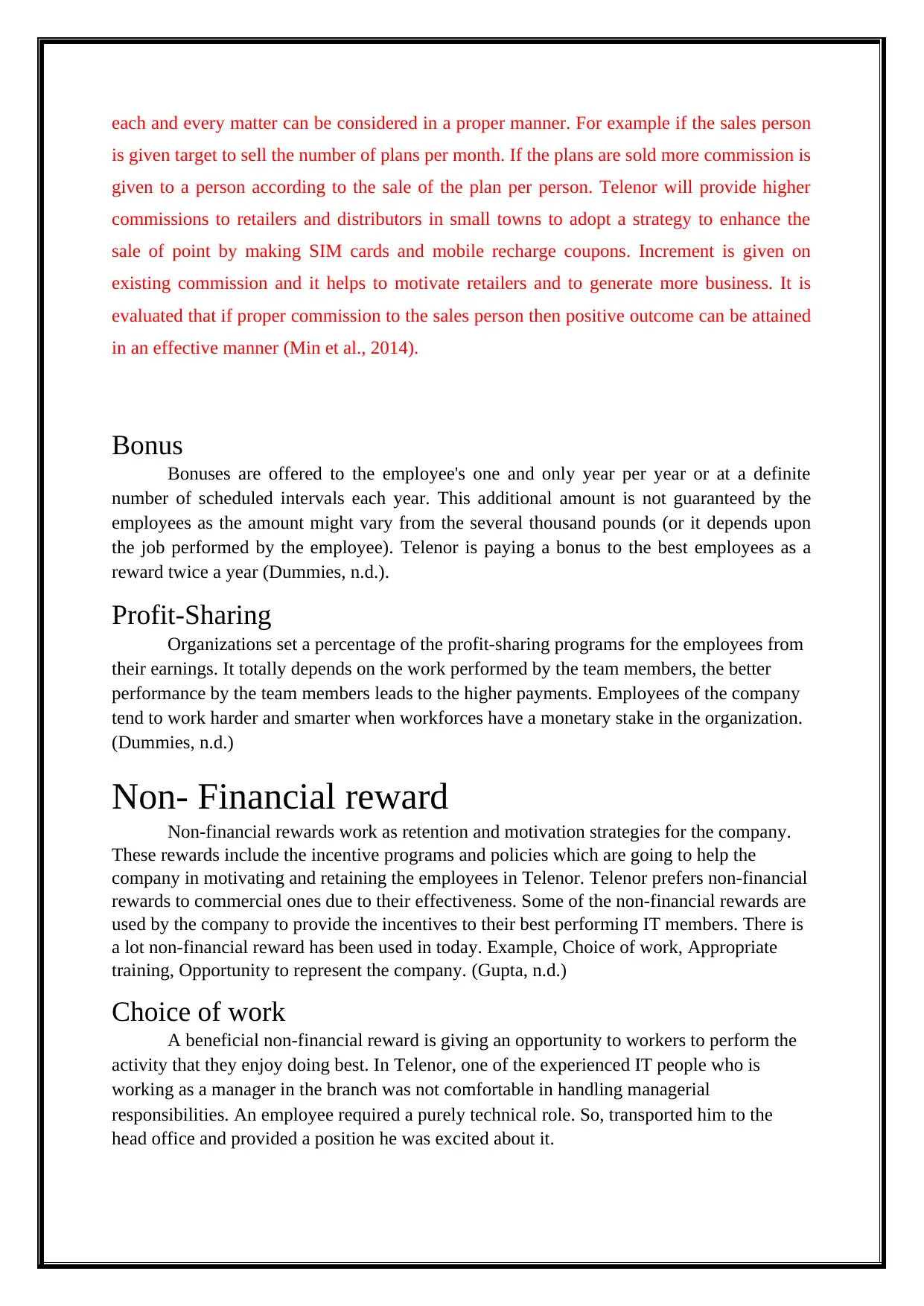
each and every matter can be considered in a proper manner. For example if the sales person
is given target to sell the number of plans per month. If the plans are sold more commission is
given to a person according to the sale of the plan per person. Telenor will provide higher
commissions to retailers and distributors in small towns to adopt a strategy to enhance the
sale of point by making SIM cards and mobile recharge coupons. Increment is given on
existing commission and it helps to motivate retailers and to generate more business. It is
evaluated that if proper commission to the sales person then positive outcome can be attained
in an effective manner (Min et al., 2014).
Bonus
Bonuses are offered to the employee's one and only year per year or at a definite
number of scheduled intervals each year. This additional amount is not guaranteed by the
employees as the amount might vary from the several thousand pounds (or it depends upon
the job performed by the employee). Telenor is paying a bonus to the best employees as a
reward twice a year (Dummies, n.d.).
Profit-Sharing
Organizations set a percentage of the profit-sharing programs for the employees from
their earnings. It totally depends on the work performed by the team members, the better
performance by the team members leads to the higher payments. Employees of the company
tend to work harder and smarter when workforces have a monetary stake in the organization.
(Dummies, n.d.)
Non- Financial reward
Non-financial rewards work as retention and motivation strategies for the company.
These rewards include the incentive programs and policies which are going to help the
company in motivating and retaining the employees in Telenor. Telenor prefers non-financial
rewards to commercial ones due to their effectiveness. Some of the non-financial rewards are
used by the company to provide the incentives to their best performing IT members. There is
a lot non-financial reward has been used in today. Example, Choice of work, Appropriate
training, Opportunity to represent the company. (Gupta, n.d.)
Choice of work
A beneficial non-financial reward is giving an opportunity to workers to perform the
activity that they enjoy doing best. In Telenor, one of the experienced IT people who is
working as a manager in the branch was not comfortable in handling managerial
responsibilities. An employee required a purely technical role. So, transported him to the
head office and provided a position he was excited about it.
is given target to sell the number of plans per month. If the plans are sold more commission is
given to a person according to the sale of the plan per person. Telenor will provide higher
commissions to retailers and distributors in small towns to adopt a strategy to enhance the
sale of point by making SIM cards and mobile recharge coupons. Increment is given on
existing commission and it helps to motivate retailers and to generate more business. It is
evaluated that if proper commission to the sales person then positive outcome can be attained
in an effective manner (Min et al., 2014).
Bonus
Bonuses are offered to the employee's one and only year per year or at a definite
number of scheduled intervals each year. This additional amount is not guaranteed by the
employees as the amount might vary from the several thousand pounds (or it depends upon
the job performed by the employee). Telenor is paying a bonus to the best employees as a
reward twice a year (Dummies, n.d.).
Profit-Sharing
Organizations set a percentage of the profit-sharing programs for the employees from
their earnings. It totally depends on the work performed by the team members, the better
performance by the team members leads to the higher payments. Employees of the company
tend to work harder and smarter when workforces have a monetary stake in the organization.
(Dummies, n.d.)
Non- Financial reward
Non-financial rewards work as retention and motivation strategies for the company.
These rewards include the incentive programs and policies which are going to help the
company in motivating and retaining the employees in Telenor. Telenor prefers non-financial
rewards to commercial ones due to their effectiveness. Some of the non-financial rewards are
used by the company to provide the incentives to their best performing IT members. There is
a lot non-financial reward has been used in today. Example, Choice of work, Appropriate
training, Opportunity to represent the company. (Gupta, n.d.)
Choice of work
A beneficial non-financial reward is giving an opportunity to workers to perform the
activity that they enjoy doing best. In Telenor, one of the experienced IT people who is
working as a manager in the branch was not comfortable in handling managerial
responsibilities. An employee required a purely technical role. So, transported him to the
head office and provided a position he was excited about it.
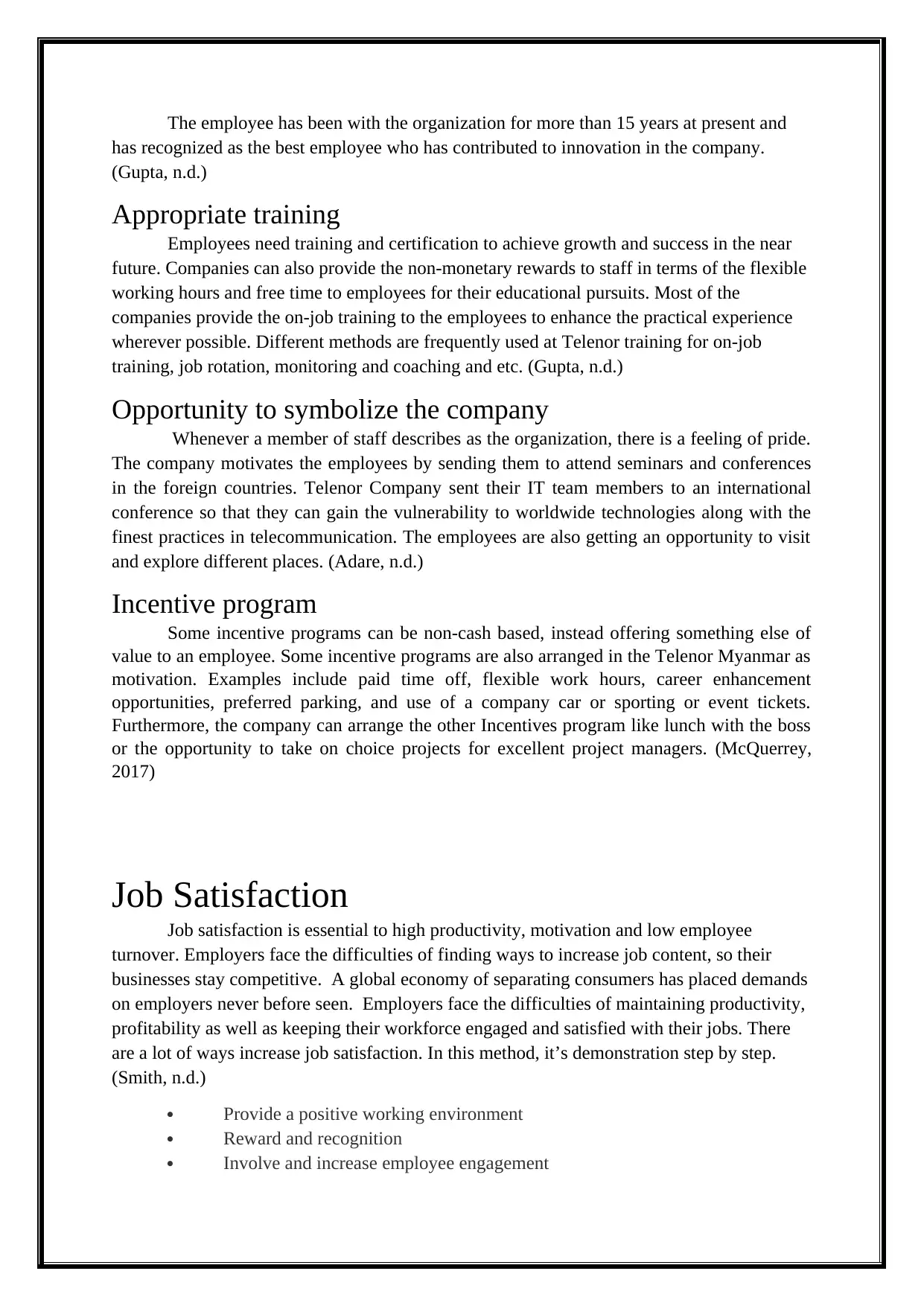
The employee has been with the organization for more than 15 years at present and
has recognized as the best employee who has contributed to innovation in the company.
(Gupta, n.d.)
Appropriate training
Employees need training and certification to achieve growth and success in the near
future. Companies can also provide the non-monetary rewards to staff in terms of the flexible
working hours and free time to employees for their educational pursuits. Most of the
companies provide the on-job training to the employees to enhance the practical experience
wherever possible. Different methods are frequently used at Telenor training for on-job
training, job rotation, monitoring and coaching and etc. (Gupta, n.d.)
Opportunity to symbolize the company
Whenever a member of staff describes as the organization, there is a feeling of pride.
The company motivates the employees by sending them to attend seminars and conferences
in the foreign countries. Telenor Company sent their IT team members to an international
conference so that they can gain the vulnerability to worldwide technologies along with the
finest practices in telecommunication. The employees are also getting an opportunity to visit
and explore different places. (Adare, n.d.)
Incentive program
Some incentive programs can be non-cash based, instead offering something else of
value to an employee. Some incentive programs are also arranged in the Telenor Myanmar as
motivation. Examples include paid time off, flexible work hours, career enhancement
opportunities, preferred parking, and use of a company car or sporting or event tickets.
Furthermore, the company can arrange the other Incentives program like lunch with the boss
or the opportunity to take on choice projects for excellent project managers. (McQuerrey,
2017)
Job Satisfaction
Job satisfaction is essential to high productivity, motivation and low employee
turnover. Employers face the difficulties of finding ways to increase job content, so their
businesses stay competitive. A global economy of separating consumers has placed demands
on employers never before seen. Employers face the difficulties of maintaining productivity,
profitability as well as keeping their workforce engaged and satisfied with their jobs. There
are a lot of ways increase job satisfaction. In this method, it’s demonstration step by step.
(Smith, n.d.)
Provide a positive working environment
Reward and recognition
Involve and increase employee engagement
has recognized as the best employee who has contributed to innovation in the company.
(Gupta, n.d.)
Appropriate training
Employees need training and certification to achieve growth and success in the near
future. Companies can also provide the non-monetary rewards to staff in terms of the flexible
working hours and free time to employees for their educational pursuits. Most of the
companies provide the on-job training to the employees to enhance the practical experience
wherever possible. Different methods are frequently used at Telenor training for on-job
training, job rotation, monitoring and coaching and etc. (Gupta, n.d.)
Opportunity to symbolize the company
Whenever a member of staff describes as the organization, there is a feeling of pride.
The company motivates the employees by sending them to attend seminars and conferences
in the foreign countries. Telenor Company sent their IT team members to an international
conference so that they can gain the vulnerability to worldwide technologies along with the
finest practices in telecommunication. The employees are also getting an opportunity to visit
and explore different places. (Adare, n.d.)
Incentive program
Some incentive programs can be non-cash based, instead offering something else of
value to an employee. Some incentive programs are also arranged in the Telenor Myanmar as
motivation. Examples include paid time off, flexible work hours, career enhancement
opportunities, preferred parking, and use of a company car or sporting or event tickets.
Furthermore, the company can arrange the other Incentives program like lunch with the boss
or the opportunity to take on choice projects for excellent project managers. (McQuerrey,
2017)
Job Satisfaction
Job satisfaction is essential to high productivity, motivation and low employee
turnover. Employers face the difficulties of finding ways to increase job content, so their
businesses stay competitive. A global economy of separating consumers has placed demands
on employers never before seen. Employers face the difficulties of maintaining productivity,
profitability as well as keeping their workforce engaged and satisfied with their jobs. There
are a lot of ways increase job satisfaction. In this method, it’s demonstration step by step.
(Smith, n.d.)
Provide a positive working environment
Reward and recognition
Involve and increase employee engagement
⊘ This is a preview!⊘
Do you want full access?
Subscribe today to unlock all pages.

Trusted by 1+ million students worldwide
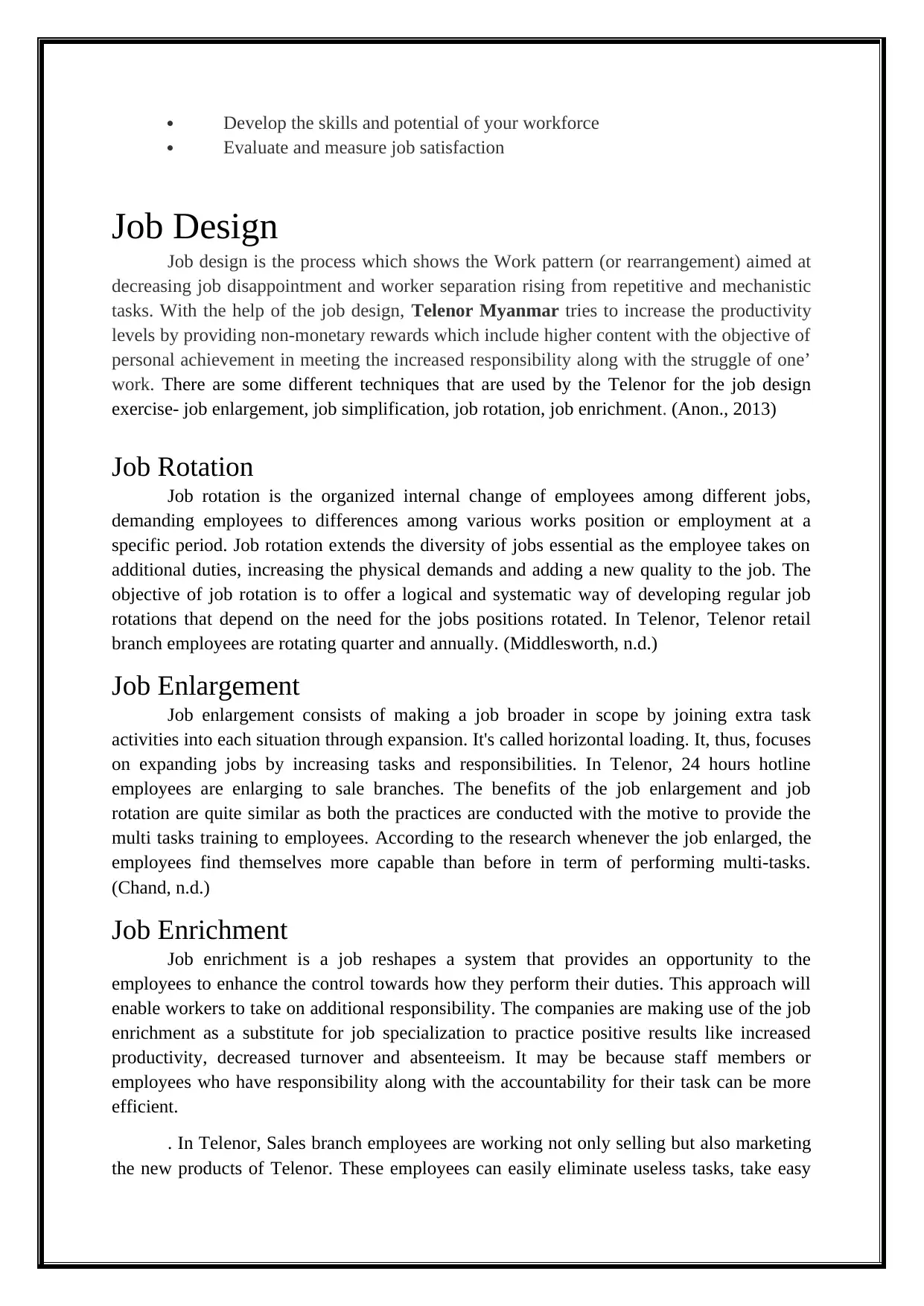
Develop the skills and potential of your workforce
Evaluate and measure job satisfaction
Job Design
Job design is the process which shows the Work pattern (or rearrangement) aimed at
decreasing job disappointment and worker separation rising from repetitive and mechanistic
tasks. With the help of the job design, Telenor Myanmar tries to increase the productivity
levels by providing non-monetary rewards which include higher content with the objective of
personal achievement in meeting the increased responsibility along with the struggle of one’
work. There are some different techniques that are used by the Telenor for the job design
exercise- job enlargement, job simplification, job rotation, job enrichment. (Anon., 2013)
Job Rotation
Job rotation is the organized internal change of employees among different jobs,
demanding employees to differences among various works position or employment at a
specific period. Job rotation extends the diversity of jobs essential as the employee takes on
additional duties, increasing the physical demands and adding a new quality to the job. The
objective of job rotation is to offer a logical and systematic way of developing regular job
rotations that depend on the need for the jobs positions rotated. In Telenor, Telenor retail
branch employees are rotating quarter and annually. (Middlesworth, n.d.)
Job Enlargement
Job enlargement consists of making a job broader in scope by joining extra task
activities into each situation through expansion. It's called horizontal loading. It, thus, focuses
on expanding jobs by increasing tasks and responsibilities. In Telenor, 24 hours hotline
employees are enlarging to sale branches. The benefits of the job enlargement and job
rotation are quite similar as both the practices are conducted with the motive to provide the
multi tasks training to employees. According to the research whenever the job enlarged, the
employees find themselves more capable than before in term of performing multi-tasks.
(Chand, n.d.)
Job Enrichment
Job enrichment is a job reshapes a system that provides an opportunity to the
employees to enhance the control towards how they perform their duties. This approach will
enable workers to take on additional responsibility. The companies are making use of the job
enrichment as a substitute for job specialization to practice positive results like increased
productivity, decreased turnover and absenteeism. It may be because staff members or
employees who have responsibility along with the accountability for their task can be more
efficient.
. In Telenor, Sales branch employees are working not only selling but also marketing
the new products of Telenor. These employees can easily eliminate useless tasks, take easy
Evaluate and measure job satisfaction
Job Design
Job design is the process which shows the Work pattern (or rearrangement) aimed at
decreasing job disappointment and worker separation rising from repetitive and mechanistic
tasks. With the help of the job design, Telenor Myanmar tries to increase the productivity
levels by providing non-monetary rewards which include higher content with the objective of
personal achievement in meeting the increased responsibility along with the struggle of one’
work. There are some different techniques that are used by the Telenor for the job design
exercise- job enlargement, job simplification, job rotation, job enrichment. (Anon., 2013)
Job Rotation
Job rotation is the organized internal change of employees among different jobs,
demanding employees to differences among various works position or employment at a
specific period. Job rotation extends the diversity of jobs essential as the employee takes on
additional duties, increasing the physical demands and adding a new quality to the job. The
objective of job rotation is to offer a logical and systematic way of developing regular job
rotations that depend on the need for the jobs positions rotated. In Telenor, Telenor retail
branch employees are rotating quarter and annually. (Middlesworth, n.d.)
Job Enlargement
Job enlargement consists of making a job broader in scope by joining extra task
activities into each situation through expansion. It's called horizontal loading. It, thus, focuses
on expanding jobs by increasing tasks and responsibilities. In Telenor, 24 hours hotline
employees are enlarging to sale branches. The benefits of the job enlargement and job
rotation are quite similar as both the practices are conducted with the motive to provide the
multi tasks training to employees. According to the research whenever the job enlarged, the
employees find themselves more capable than before in term of performing multi-tasks.
(Chand, n.d.)
Job Enrichment
Job enrichment is a job reshapes a system that provides an opportunity to the
employees to enhance the control towards how they perform their duties. This approach will
enable workers to take on additional responsibility. The companies are making use of the job
enrichment as a substitute for job specialization to practice positive results like increased
productivity, decreased turnover and absenteeism. It may be because staff members or
employees who have responsibility along with the accountability for their task can be more
efficient.
. In Telenor, Sales branch employees are working not only selling but also marketing
the new products of Telenor. These employees can easily eliminate useless tasks, take easy
Paraphrase This Document
Need a fresh take? Get an instant paraphrase of this document with our AI Paraphraser
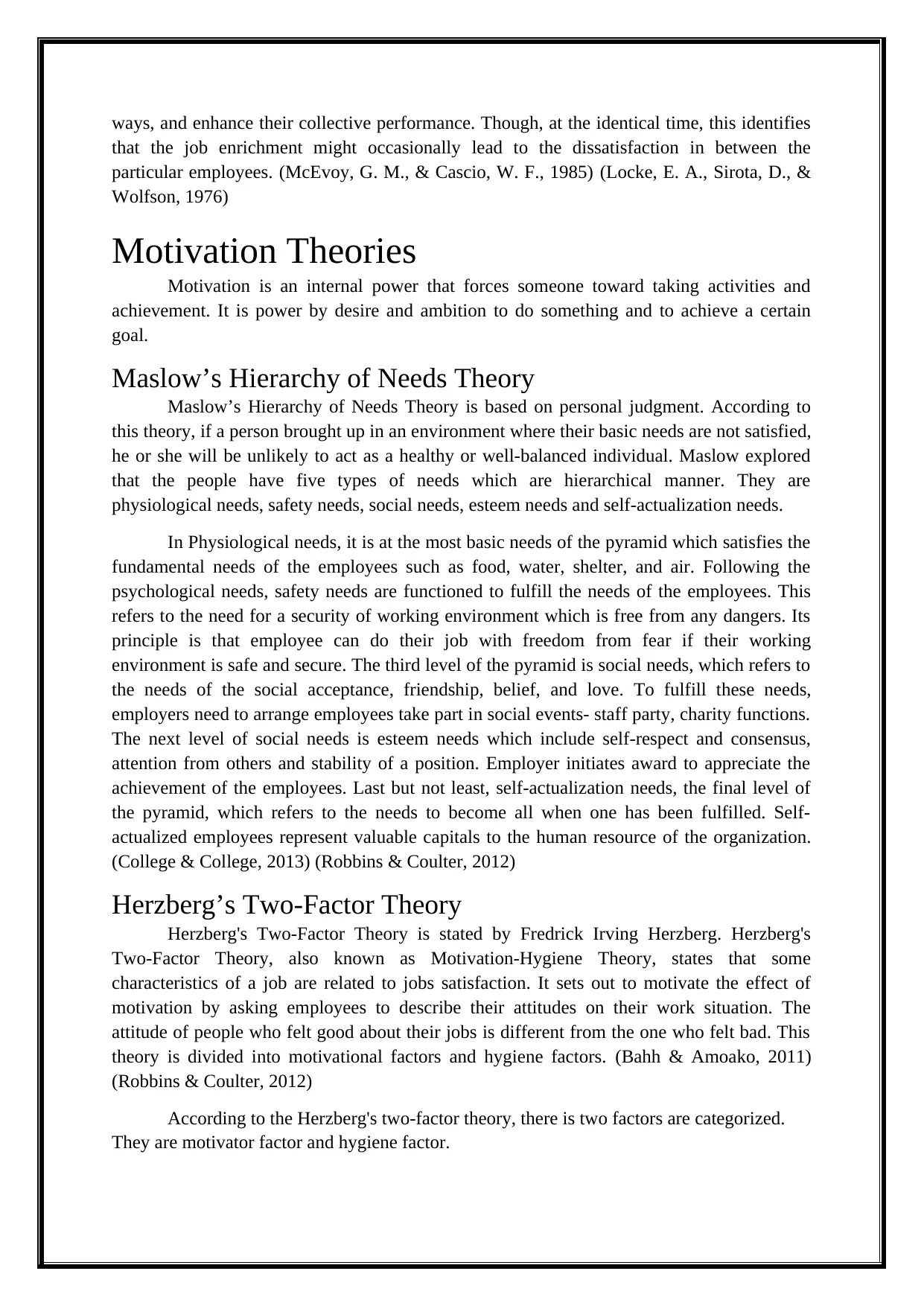
ways, and enhance their collective performance. Though, at the identical time, this identifies
that the job enrichment might occasionally lead to the dissatisfaction in between the
particular employees. (McEvoy, G. M., & Cascio, W. F., 1985) (Locke, E. A., Sirota, D., &
Wolfson, 1976)
Motivation Theories
Motivation is an internal power that forces someone toward taking activities and
achievement. It is power by desire and ambition to do something and to achieve a certain
goal.
Maslow’s Hierarchy of Needs Theory
Maslow’s Hierarchy of Needs Theory is based on personal judgment. According to
this theory, if a person brought up in an environment where their basic needs are not satisfied,
he or she will be unlikely to act as a healthy or well-balanced individual. Maslow explored
that the people have five types of needs which are hierarchical manner. They are
physiological needs, safety needs, social needs, esteem needs and self-actualization needs.
In Physiological needs, it is at the most basic needs of the pyramid which satisfies the
fundamental needs of the employees such as food, water, shelter, and air. Following the
psychological needs, safety needs are functioned to fulfill the needs of the employees. This
refers to the need for a security of working environment which is free from any dangers. Its
principle is that employee can do their job with freedom from fear if their working
environment is safe and secure. The third level of the pyramid is social needs, which refers to
the needs of the social acceptance, friendship, belief, and love. To fulfill these needs,
employers need to arrange employees take part in social events- staff party, charity functions.
The next level of social needs is esteem needs which include self-respect and consensus,
attention from others and stability of a position. Employer initiates award to appreciate the
achievement of the employees. Last but not least, self-actualization needs, the final level of
the pyramid, which refers to the needs to become all when one has been fulfilled. Self-
actualized employees represent valuable capitals to the human resource of the organization.
(College & College, 2013) (Robbins & Coulter, 2012)
Herzberg’s Two-Factor Theory
Herzberg's Two-Factor Theory is stated by Fredrick Irving Herzberg. Herzberg's
Two-Factor Theory, also known as Motivation-Hygiene Theory, states that some
characteristics of a job are related to jobs satisfaction. It sets out to motivate the effect of
motivation by asking employees to describe their attitudes on their work situation. The
attitude of people who felt good about their jobs is different from the one who felt bad. This
theory is divided into motivational factors and hygiene factors. (Bahh & Amoako, 2011)
(Robbins & Coulter, 2012)
According to the Herzberg's two-factor theory, there is two factors are categorized.
They are motivator factor and hygiene factor.
that the job enrichment might occasionally lead to the dissatisfaction in between the
particular employees. (McEvoy, G. M., & Cascio, W. F., 1985) (Locke, E. A., Sirota, D., &
Wolfson, 1976)
Motivation Theories
Motivation is an internal power that forces someone toward taking activities and
achievement. It is power by desire and ambition to do something and to achieve a certain
goal.
Maslow’s Hierarchy of Needs Theory
Maslow’s Hierarchy of Needs Theory is based on personal judgment. According to
this theory, if a person brought up in an environment where their basic needs are not satisfied,
he or she will be unlikely to act as a healthy or well-balanced individual. Maslow explored
that the people have five types of needs which are hierarchical manner. They are
physiological needs, safety needs, social needs, esteem needs and self-actualization needs.
In Physiological needs, it is at the most basic needs of the pyramid which satisfies the
fundamental needs of the employees such as food, water, shelter, and air. Following the
psychological needs, safety needs are functioned to fulfill the needs of the employees. This
refers to the need for a security of working environment which is free from any dangers. Its
principle is that employee can do their job with freedom from fear if their working
environment is safe and secure. The third level of the pyramid is social needs, which refers to
the needs of the social acceptance, friendship, belief, and love. To fulfill these needs,
employers need to arrange employees take part in social events- staff party, charity functions.
The next level of social needs is esteem needs which include self-respect and consensus,
attention from others and stability of a position. Employer initiates award to appreciate the
achievement of the employees. Last but not least, self-actualization needs, the final level of
the pyramid, which refers to the needs to become all when one has been fulfilled. Self-
actualized employees represent valuable capitals to the human resource of the organization.
(College & College, 2013) (Robbins & Coulter, 2012)
Herzberg’s Two-Factor Theory
Herzberg's Two-Factor Theory is stated by Fredrick Irving Herzberg. Herzberg's
Two-Factor Theory, also known as Motivation-Hygiene Theory, states that some
characteristics of a job are related to jobs satisfaction. It sets out to motivate the effect of
motivation by asking employees to describe their attitudes on their work situation. The
attitude of people who felt good about their jobs is different from the one who felt bad. This
theory is divided into motivational factors and hygiene factors. (Bahh & Amoako, 2011)
(Robbins & Coulter, 2012)
According to the Herzberg's two-factor theory, there is two factors are categorized.
They are motivator factor and hygiene factor.
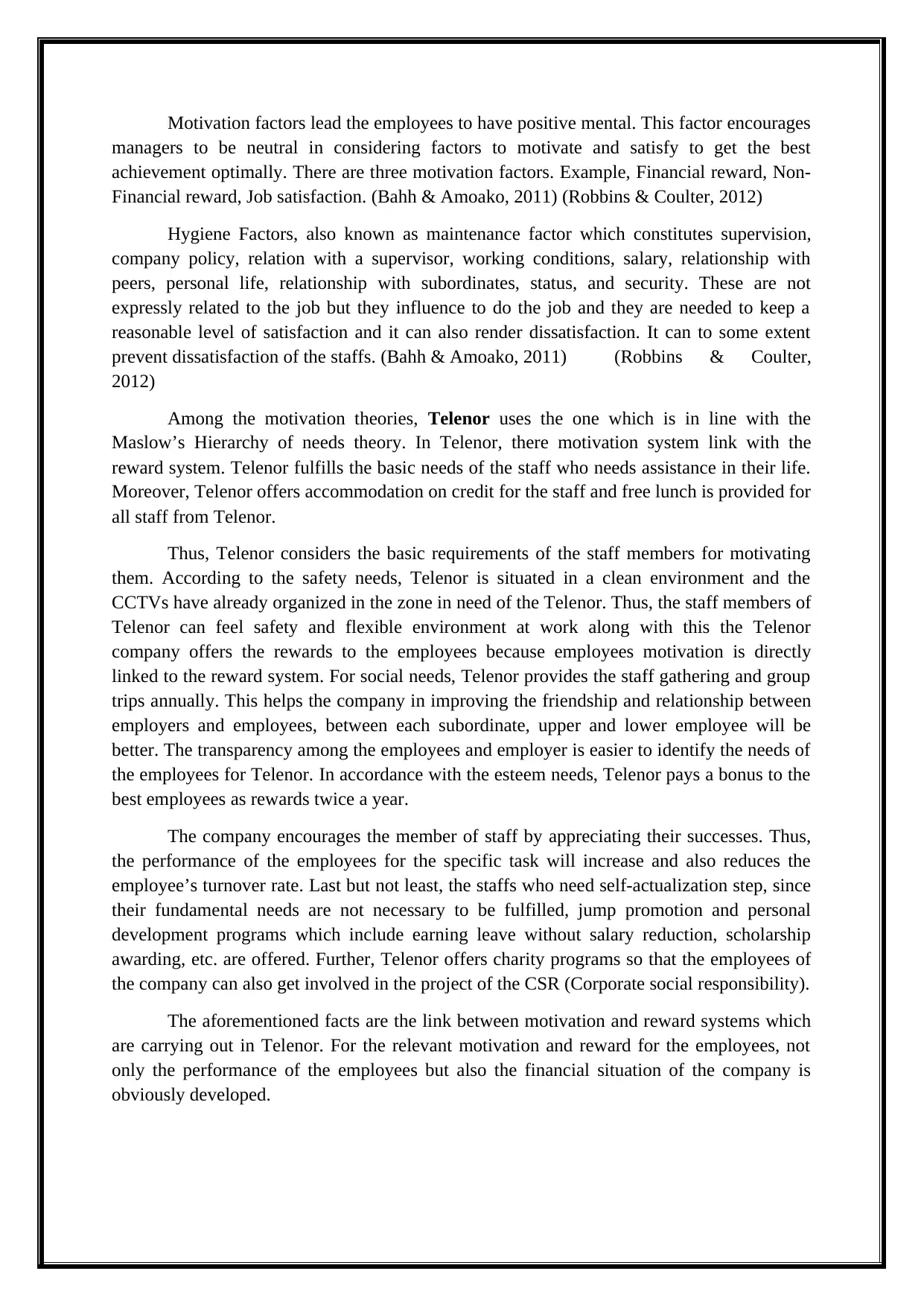
Motivation factors lead the employees to have positive mental. This factor encourages
managers to be neutral in considering factors to motivate and satisfy to get the best
achievement optimally. There are three motivation factors. Example, Financial reward, Non-
Financial reward, Job satisfaction. (Bahh & Amoako, 2011) (Robbins & Coulter, 2012)
Hygiene Factors, also known as maintenance factor which constitutes supervision,
company policy, relation with a supervisor, working conditions, salary, relationship with
peers, personal life, relationship with subordinates, status, and security. These are not
expressly related to the job but they influence to do the job and they are needed to keep a
reasonable level of satisfaction and it can also render dissatisfaction. It can to some extent
prevent dissatisfaction of the staffs. (Bahh & Amoako, 2011) (Robbins & Coulter,
2012)
Among the motivation theories, Telenor uses the one which is in line with the
Maslow’s Hierarchy of needs theory. In Telenor, there motivation system link with the
reward system. Telenor fulfills the basic needs of the staff who needs assistance in their life.
Moreover, Telenor offers accommodation on credit for the staff and free lunch is provided for
all staff from Telenor.
Thus, Telenor considers the basic requirements of the staff members for motivating
them. According to the safety needs, Telenor is situated in a clean environment and the
CCTVs have already organized in the zone in need of the Telenor. Thus, the staff members of
Telenor can feel safety and flexible environment at work along with this the Telenor
company offers the rewards to the employees because employees motivation is directly
linked to the reward system. For social needs, Telenor provides the staff gathering and group
trips annually. This helps the company in improving the friendship and relationship between
employers and employees, between each subordinate, upper and lower employee will be
better. The transparency among the employees and employer is easier to identify the needs of
the employees for Telenor. In accordance with the esteem needs, Telenor pays a bonus to the
best employees as rewards twice a year.
The company encourages the member of staff by appreciating their successes. Thus,
the performance of the employees for the specific task will increase and also reduces the
employee’s turnover rate. Last but not least, the staffs who need self-actualization step, since
their fundamental needs are not necessary to be fulfilled, jump promotion and personal
development programs which include earning leave without salary reduction, scholarship
awarding, etc. are offered. Further, Telenor offers charity programs so that the employees of
the company can also get involved in the project of the CSR (Corporate social responsibility).
The aforementioned facts are the link between motivation and reward systems which
are carrying out in Telenor. For the relevant motivation and reward for the employees, not
only the performance of the employees but also the financial situation of the company is
obviously developed.
managers to be neutral in considering factors to motivate and satisfy to get the best
achievement optimally. There are three motivation factors. Example, Financial reward, Non-
Financial reward, Job satisfaction. (Bahh & Amoako, 2011) (Robbins & Coulter, 2012)
Hygiene Factors, also known as maintenance factor which constitutes supervision,
company policy, relation with a supervisor, working conditions, salary, relationship with
peers, personal life, relationship with subordinates, status, and security. These are not
expressly related to the job but they influence to do the job and they are needed to keep a
reasonable level of satisfaction and it can also render dissatisfaction. It can to some extent
prevent dissatisfaction of the staffs. (Bahh & Amoako, 2011) (Robbins & Coulter,
2012)
Among the motivation theories, Telenor uses the one which is in line with the
Maslow’s Hierarchy of needs theory. In Telenor, there motivation system link with the
reward system. Telenor fulfills the basic needs of the staff who needs assistance in their life.
Moreover, Telenor offers accommodation on credit for the staff and free lunch is provided for
all staff from Telenor.
Thus, Telenor considers the basic requirements of the staff members for motivating
them. According to the safety needs, Telenor is situated in a clean environment and the
CCTVs have already organized in the zone in need of the Telenor. Thus, the staff members of
Telenor can feel safety and flexible environment at work along with this the Telenor
company offers the rewards to the employees because employees motivation is directly
linked to the reward system. For social needs, Telenor provides the staff gathering and group
trips annually. This helps the company in improving the friendship and relationship between
employers and employees, between each subordinate, upper and lower employee will be
better. The transparency among the employees and employer is easier to identify the needs of
the employees for Telenor. In accordance with the esteem needs, Telenor pays a bonus to the
best employees as rewards twice a year.
The company encourages the member of staff by appreciating their successes. Thus,
the performance of the employees for the specific task will increase and also reduces the
employee’s turnover rate. Last but not least, the staffs who need self-actualization step, since
their fundamental needs are not necessary to be fulfilled, jump promotion and personal
development programs which include earning leave without salary reduction, scholarship
awarding, etc. are offered. Further, Telenor offers charity programs so that the employees of
the company can also get involved in the project of the CSR (Corporate social responsibility).
The aforementioned facts are the link between motivation and reward systems which
are carrying out in Telenor. For the relevant motivation and reward for the employees, not
only the performance of the employees but also the financial situation of the company is
obviously developed.
⊘ This is a preview!⊘
Do you want full access?
Subscribe today to unlock all pages.

Trusted by 1+ million students worldwide
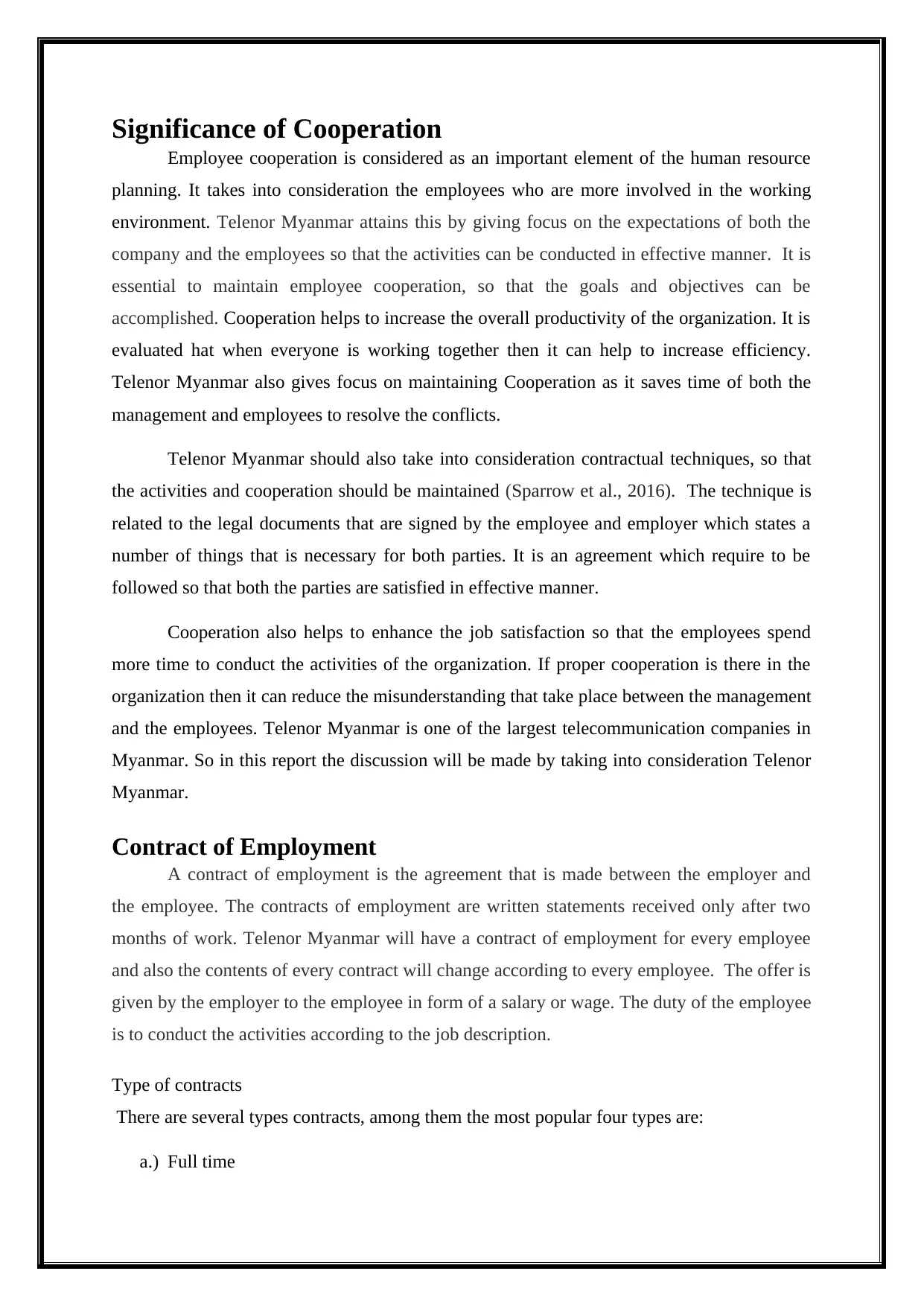
Significance of Cooperation
Employee cooperation is considered as an important element of the human resource
planning. It takes into consideration the employees who are more involved in the working
environment. Telenor Myanmar attains this by giving focus on the expectations of both the
company and the employees so that the activities can be conducted in effective manner. It is
essential to maintain employee cooperation, so that the goals and objectives can be
accomplished. Cooperation helps to increase the overall productivity of the organization. It is
evaluated hat when everyone is working together then it can help to increase efficiency.
Telenor Myanmar also gives focus on maintaining Cooperation as it saves time of both the
management and employees to resolve the conflicts.
Telenor Myanmar should also take into consideration contractual techniques, so that
the activities and cooperation should be maintained (Sparrow et al., 2016). The technique is
related to the legal documents that are signed by the employee and employer which states a
number of things that is necessary for both parties. It is an agreement which require to be
followed so that both the parties are satisfied in effective manner.
Cooperation also helps to enhance the job satisfaction so that the employees spend
more time to conduct the activities of the organization. If proper cooperation is there in the
organization then it can reduce the misunderstanding that take place between the management
and the employees. Telenor Myanmar is one of the largest telecommunication companies in
Myanmar. So in this report the discussion will be made by taking into consideration Telenor
Myanmar.
Contract of Employment
A contract of employment is the agreement that is made between the employer and
the employee. The contracts of employment are written statements received only after two
months of work. Telenor Myanmar will have a contract of employment for every employee
and also the contents of every contract will change according to every employee. The offer is
given by the employer to the employee in form of a salary or wage. The duty of the employee
is to conduct the activities according to the job description.
Type of contracts
There are several types contracts, among them the most popular four types are:
a.) Full time
Employee cooperation is considered as an important element of the human resource
planning. It takes into consideration the employees who are more involved in the working
environment. Telenor Myanmar attains this by giving focus on the expectations of both the
company and the employees so that the activities can be conducted in effective manner. It is
essential to maintain employee cooperation, so that the goals and objectives can be
accomplished. Cooperation helps to increase the overall productivity of the organization. It is
evaluated hat when everyone is working together then it can help to increase efficiency.
Telenor Myanmar also gives focus on maintaining Cooperation as it saves time of both the
management and employees to resolve the conflicts.
Telenor Myanmar should also take into consideration contractual techniques, so that
the activities and cooperation should be maintained (Sparrow et al., 2016). The technique is
related to the legal documents that are signed by the employee and employer which states a
number of things that is necessary for both parties. It is an agreement which require to be
followed so that both the parties are satisfied in effective manner.
Cooperation also helps to enhance the job satisfaction so that the employees spend
more time to conduct the activities of the organization. If proper cooperation is there in the
organization then it can reduce the misunderstanding that take place between the management
and the employees. Telenor Myanmar is one of the largest telecommunication companies in
Myanmar. So in this report the discussion will be made by taking into consideration Telenor
Myanmar.
Contract of Employment
A contract of employment is the agreement that is made between the employer and
the employee. The contracts of employment are written statements received only after two
months of work. Telenor Myanmar will have a contract of employment for every employee
and also the contents of every contract will change according to every employee. The offer is
given by the employer to the employee in form of a salary or wage. The duty of the employee
is to conduct the activities according to the job description.
Type of contracts
There are several types contracts, among them the most popular four types are:
a.) Full time
Paraphrase This Document
Need a fresh take? Get an instant paraphrase of this document with our AI Paraphraser
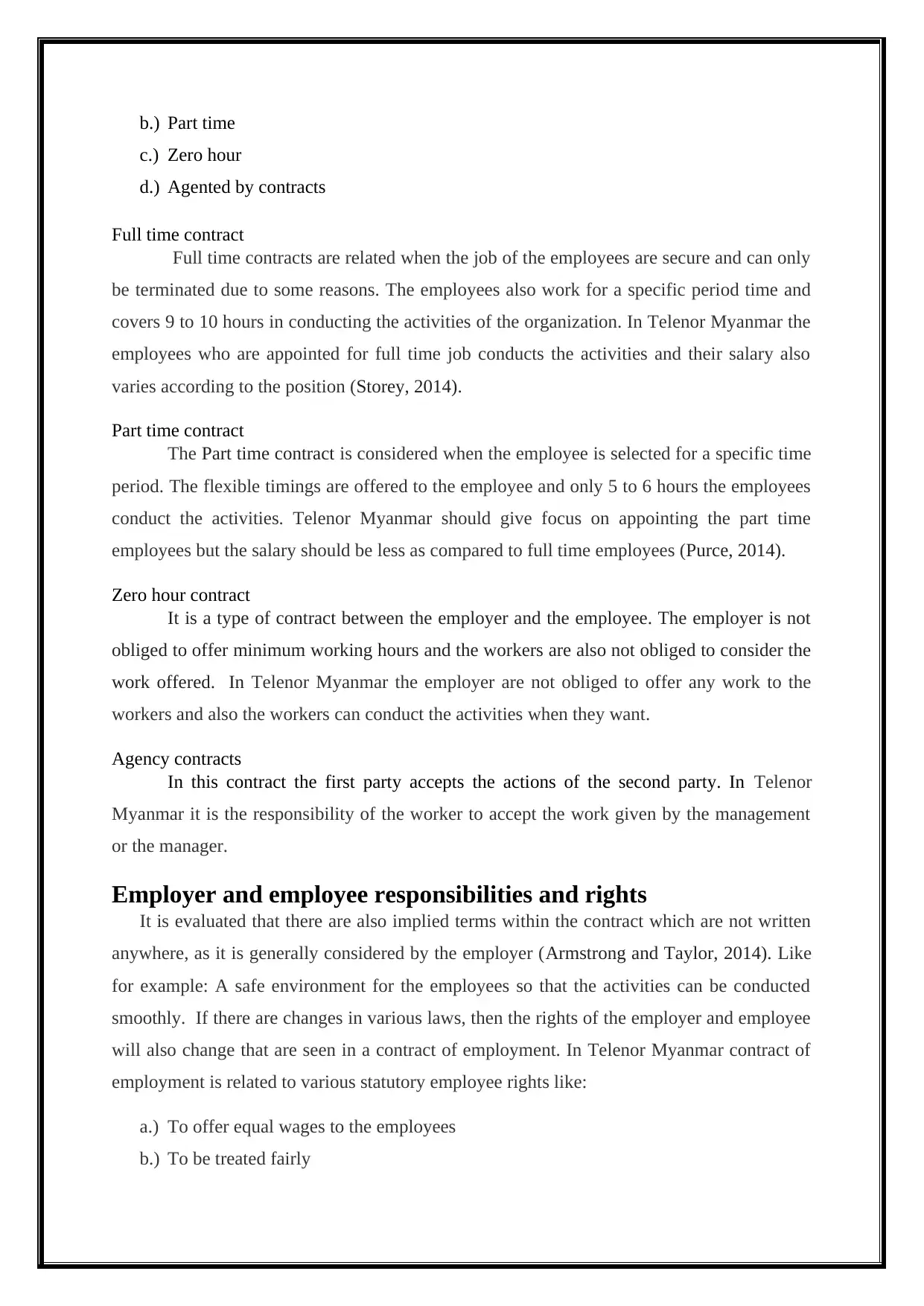
b.) Part time
c.) Zero hour
d.) Agented by contracts
Full time contract
Full time contracts are related when the job of the employees are secure and can only
be terminated due to some reasons. The employees also work for a specific period time and
covers 9 to 10 hours in conducting the activities of the organization. In Telenor Myanmar the
employees who are appointed for full time job conducts the activities and their salary also
varies according to the position (Storey, 2014).
Part time contract
The Part time contract is considered when the employee is selected for a specific time
period. The flexible timings are offered to the employee and only 5 to 6 hours the employees
conduct the activities. Telenor Myanmar should give focus on appointing the part time
employees but the salary should be less as compared to full time employees (Purce, 2014).
Zero hour contract
It is a type of contract between the employer and the employee. The employer is not
obliged to offer minimum working hours and the workers are also not obliged to consider the
work offered. In Telenor Myanmar the employer are not obliged to offer any work to the
workers and also the workers can conduct the activities when they want.
Agency contracts
In this contract the first party accepts the actions of the second party. In Telenor
Myanmar it is the responsibility of the worker to accept the work given by the management
or the manager.
Employer and employee responsibilities and rights
It is evaluated that there are also implied terms within the contract which are not written
anywhere, as it is generally considered by the employer (Armstrong and Taylor, 2014). Like
for example: A safe environment for the employees so that the activities can be conducted
smoothly. If there are changes in various laws, then the rights of the employer and employee
will also change that are seen in a contract of employment. In Telenor Myanmar contract of
employment is related to various statutory employee rights like:
a.) To offer equal wages to the employees
b.) To be treated fairly
c.) Zero hour
d.) Agented by contracts
Full time contract
Full time contracts are related when the job of the employees are secure and can only
be terminated due to some reasons. The employees also work for a specific period time and
covers 9 to 10 hours in conducting the activities of the organization. In Telenor Myanmar the
employees who are appointed for full time job conducts the activities and their salary also
varies according to the position (Storey, 2014).
Part time contract
The Part time contract is considered when the employee is selected for a specific time
period. The flexible timings are offered to the employee and only 5 to 6 hours the employees
conduct the activities. Telenor Myanmar should give focus on appointing the part time
employees but the salary should be less as compared to full time employees (Purce, 2014).
Zero hour contract
It is a type of contract between the employer and the employee. The employer is not
obliged to offer minimum working hours and the workers are also not obliged to consider the
work offered. In Telenor Myanmar the employer are not obliged to offer any work to the
workers and also the workers can conduct the activities when they want.
Agency contracts
In this contract the first party accepts the actions of the second party. In Telenor
Myanmar it is the responsibility of the worker to accept the work given by the management
or the manager.
Employer and employee responsibilities and rights
It is evaluated that there are also implied terms within the contract which are not written
anywhere, as it is generally considered by the employer (Armstrong and Taylor, 2014). Like
for example: A safe environment for the employees so that the activities can be conducted
smoothly. If there are changes in various laws, then the rights of the employer and employee
will also change that are seen in a contract of employment. In Telenor Myanmar contract of
employment is related to various statutory employee rights like:
a.) To offer equal wages to the employees
b.) To be treated fairly
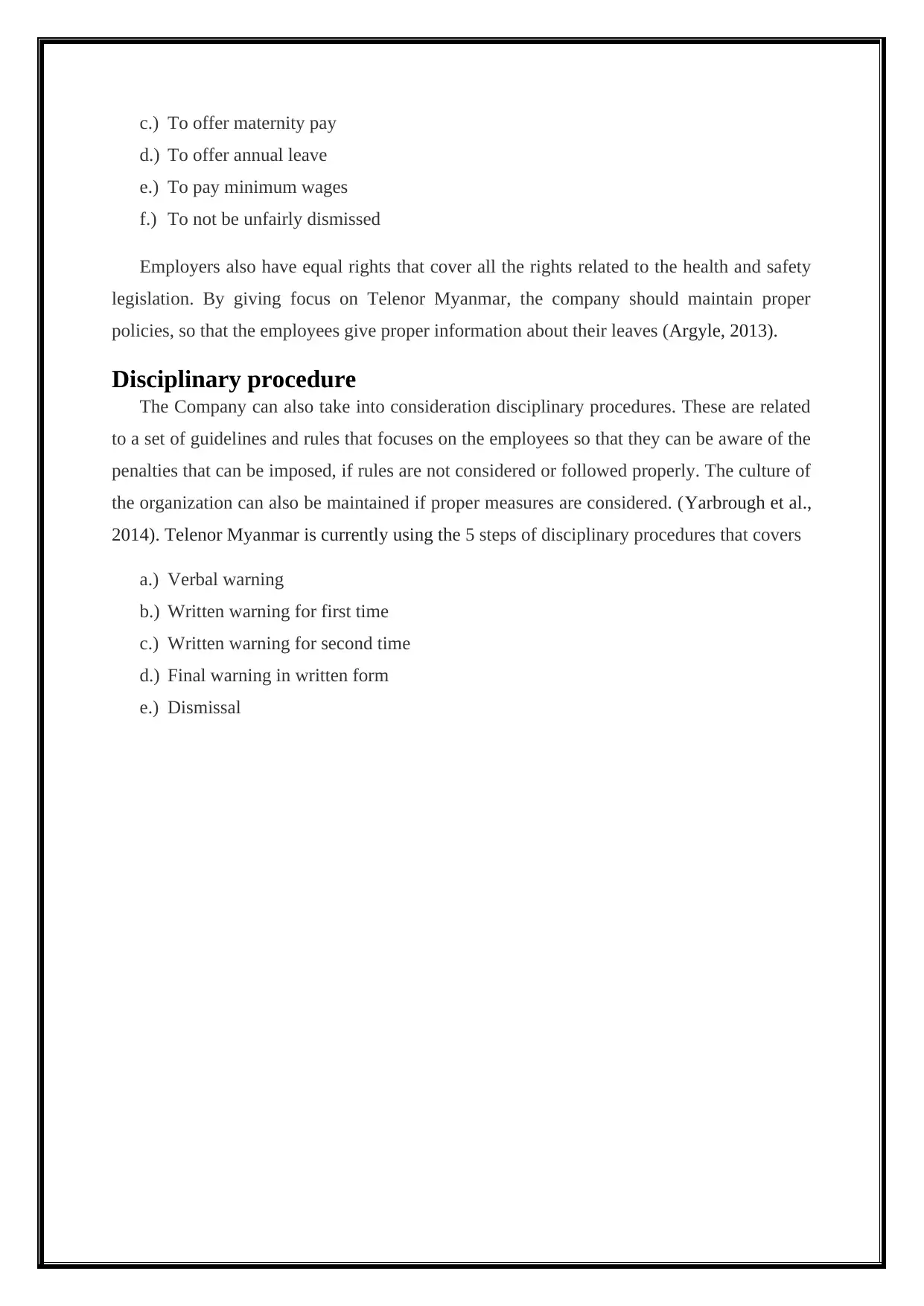
c.) To offer maternity pay
d.) To offer annual leave
e.) To pay minimum wages
f.) To not be unfairly dismissed
Employers also have equal rights that cover all the rights related to the health and safety
legislation. By giving focus on Telenor Myanmar, the company should maintain proper
policies, so that the employees give proper information about their leaves (Argyle, 2013).
Disciplinary procedure
The Company can also take into consideration disciplinary procedures. These are related
to a set of guidelines and rules that focuses on the employees so that they can be aware of the
penalties that can be imposed, if rules are not considered or followed properly. The culture of
the organization can also be maintained if proper measures are considered. (Yarbrough et al.,
2014). Telenor Myanmar is currently using the 5 steps of disciplinary procedures that covers
a.) Verbal warning
b.) Written warning for first time
c.) Written warning for second time
d.) Final warning in written form
e.) Dismissal
d.) To offer annual leave
e.) To pay minimum wages
f.) To not be unfairly dismissed
Employers also have equal rights that cover all the rights related to the health and safety
legislation. By giving focus on Telenor Myanmar, the company should maintain proper
policies, so that the employees give proper information about their leaves (Argyle, 2013).
Disciplinary procedure
The Company can also take into consideration disciplinary procedures. These are related
to a set of guidelines and rules that focuses on the employees so that they can be aware of the
penalties that can be imposed, if rules are not considered or followed properly. The culture of
the organization can also be maintained if proper measures are considered. (Yarbrough et al.,
2014). Telenor Myanmar is currently using the 5 steps of disciplinary procedures that covers
a.) Verbal warning
b.) Written warning for first time
c.) Written warning for second time
d.) Final warning in written form
e.) Dismissal
⊘ This is a preview!⊘
Do you want full access?
Subscribe today to unlock all pages.

Trusted by 1+ million students worldwide
1 out of 23
Related Documents
Your All-in-One AI-Powered Toolkit for Academic Success.
+13062052269
info@desklib.com
Available 24*7 on WhatsApp / Email
![[object Object]](/_next/static/media/star-bottom.7253800d.svg)
Unlock your academic potential
Copyright © 2020–2025 A2Z Services. All Rights Reserved. Developed and managed by ZUCOL.




